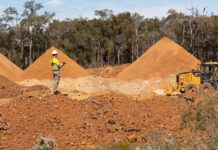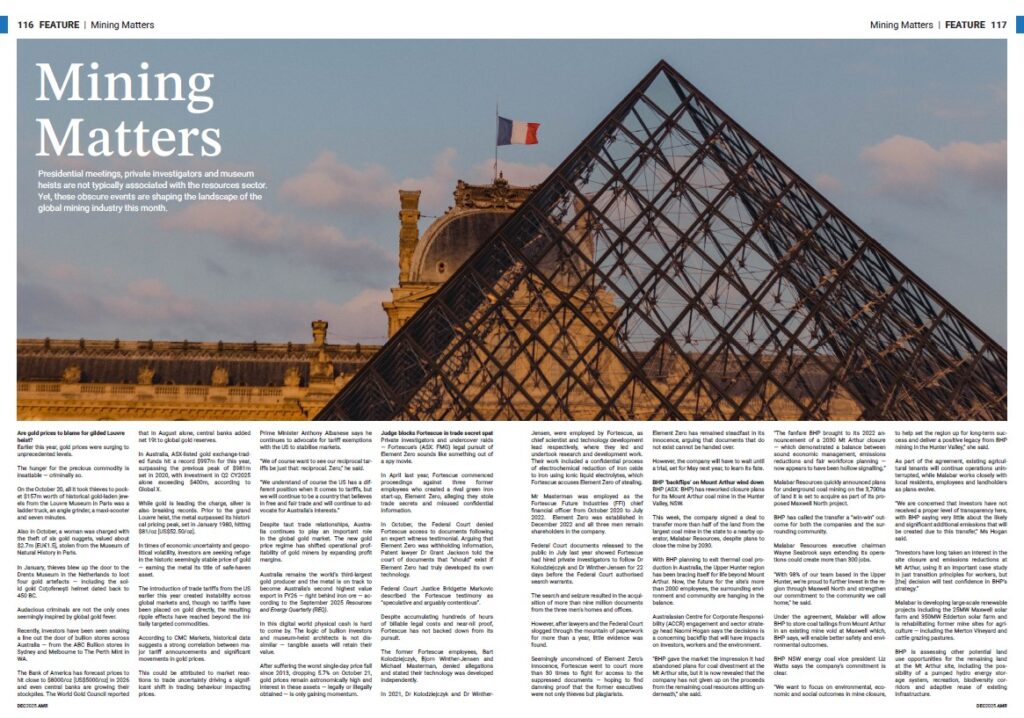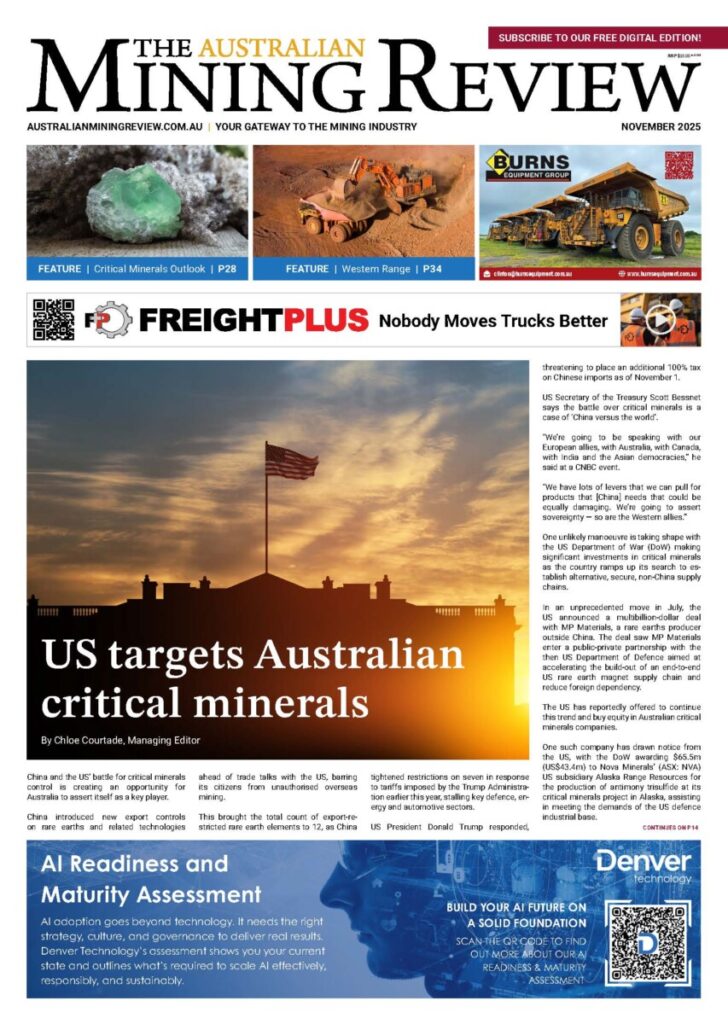Mining Matters

Presidential meetings, private investigators and museum heists are not typically associated with the resources sector. Yet, these obscure events are shaping the landscape of the global mining industry this month.
Are gold prices to blame for gilded Louvre heist?
Earlier this year, gold prices were surging to unprecedented levels.
The hunger for the precious commodity is insatiable — criminally so.
On October 20, all it took thieves to pocket $157m worth of historical gold-laden jewels from the Louvre Museum in Paris was a ladder truck, an angle grinder, a maxi-scooter and seven minutes.
Also in October, a woman was charged with the theft of six gold nuggets, valued about $2.7m [EU€1.5], stolen from the Museum of Natural History in Paris.
In January, thieves blew up the door to the Drents Museum in the Netherlands to loot four gold artefacts — including the solid gold Co?ofene?ti helmet dated back to 450 BC.
Audacious criminals are not the only ones seemingly inspired by global gold fever.
Recently, investors have been seen snaking a line out the door of bullion stores across Australia — from the ABC Bullion stores in Sydney and Melbourne to The Perth Mint in WA.
The Bank of America has forecast prices to hit close to $8000/oz [US$5000/oz] in 2026 and even central banks are growing their stockpiles. The World Gold Council reported that in August alone, central banks added net 19t to global gold reserves.
In Australia, ASX-listed gold exchange-traded funds hit a record $997m for this year, surpassing the previous peak of $981m set in 2020, with investment in Q2 CY2025 alone exceeding $400m, according to Global X.
While gold is leading the charge, silver is also breaking records. Prior to the grand Louvre heist, the metal surpassed its historical pricing peak, set in January 1980, hitting $81/oz [US$52.50/oz].
In times of economic uncertainty and geopolitical volatility, investors are seeking refuge in the historic seemingly stable price of gold — earning the metal its title of safe-haven asset.
The introduction of trade tariffs from the US earlier this year created instability across global markets and, though no tariffs have been placed on gold directly, the resulting ripple effects have reached beyond the initially targeted commodities.
According to CMC Markets, historical data suggests a strong correlation between major tariff announcements and significant movements in gold prices.
This could be attributed to market reactions to trade uncertainty driving a significant shift in trading behaviour impacting prices.
Prime Minister Anthony Albanese says he continues to advocate for tariff exemptions with the US to stabilise markets.
“We of course want to see our reciprocal tariffs be just that: reciprocal. Zero,” he said.
“We understand of course the US has a different position when it comes to tariffs, but we will continue to be a country that believes in free and fair trade and will continue to advocate for Australia’s interests.”
Despite taut trade relationships, Australia continues to play an important role in the global gold market. The new gold price regime has shifted operational profitability of gold miners by expanding profit margins.
Australia remains the world’s third-largest gold producer and the metal is on track to become Australia’s second highest value export in FY26 — right behind iron ore — according to the September 2025 Resources and Energy Quarterly (REQ).
In this digital world physical cash is hard to come by. The logic of bullion investors and museum-heist architects is not dissimilar — tangible assets will retain their value.
After suffering the worst single-day price fall since 2013, dropping 5.7% on October 21, gold prices remain astronomically high and interest in these assets — legally or illegally obtained — is only gaining momentum.
Judge blocks Fortescue in trade secret spat
Private investigators and undercover raids — Fortescue’s (ASX: FMG) legal pursuit of Element Zero sounds like something out of a spy movie.
In April last year, Fortescue commenced proceedings against three former employees who created a rival green iron start-up, Element Zero, alleging they stole trade secrets and misused confidential information.
In October, the Federal Court denied Fortescue access to documents following an expert witness testimonial. Arguing that Element Zero was withholding information, Patent lawyer Dr Grant Jackson told the court of documents that “should” exist if Element Zero had truly developed its own technology.
Federal Court Justice Bridgette Markovic described the Fortescue testimony as “speculative and arguably contentious”.
Despite accumulating hundreds of hours of billable legal costs and near-nil proof, Fortescue has not backed down from its pursuit.
The former Fortescue employees, Bart Kolodziejczyk, Bjorn Winther-Jensen and Michael Masterman, denied allegations and stated their technology was developed independently.
In 2021, Dr Kolodziejczyk and Dr Winther-Jensen, were employed by Fortescue, as chief scientist and technology development lead respectively, where they led and undertook research and development work. Their work included a confidential process of electrochemical reduction of iron oxide to iron using ionic liquid electrolytes, which Fortescue accuses Element Zero of stealing.
Mr Masterman was employed as the Fortescue Future Industries (FFI) chief financial officer from October 2020 to July 2022. Element Zero was established in December 2022 and all three men remain shareholders in the company.
Federal Court documents released to the public in July last year showed Fortescue had hired private investigators to follow Dr Kolodziejczyk and Dr Winther-Jensen for 22 days before the Federal Court authorised search warrants.
The search and seizure resulted in the acquisition of more than nine million documents from the three men’s homes and offices.
However, after lawyers and the Federal Court slogged through the mountain of paperwork for more than a year, little evidence was found.
Seemingly unconvinced of Element Zero’s innocence, Fortescue went to court more than 30 times to fight for access to the suppressed documents — hoping to find damning proof that the former executives were not only thieves but plagiarists.
Element Zero has remained steadfast in its innocence, arguing that documents that do not exist cannot be handed over.
However, the company will have to wait until a trial, set for May next year, to learn its fate.
BHP ‘backflips’ on Mount Arthur wind down
BHP (ASX: BHP) has reworked closure plans for its Mount Arthur coal mine in the Hunter Valley, NSW.
This week, the company signed a deal to transfer more than half of the land from the largest coal mine in the state to a nearby operator, Malabar Resources, despite plans to close the mine by 2030.
With BHP planning to exit thermal coal production in Australia, the Upper Hunter region has been bracing itself for life beyond Mount Arthur. Now, the future for the site’s more than 2000 employees, the surrounding environment and community are hanging in the balance.
Australasian Centre for Corporate Responsibility (ACCR) engagement and sector strategy head Naomi Hogan says the decisions is a concerning backflip that will have impacts on investors, workers and the environment.
“BHP gave the market the impression it had abandoned plans for coal divestment at the Mt Arthur site, but it is now revealed that the company has not given up on the proceeds from the remaining coal resources sitting underneath,” she said.
“The fanfare BHP brought to its 2022 announcement of a 2030 Mt Arthur closure — which demonstrated a balance between sound economic management, emissions reductions and fair workforce planning — now appears to have been hollow signalling.”
Malabar Resources quickly announced plans for underground coal mining on the 3,700ha of land it is set to acquire as part of its proposed Maxwell North project.
BHP has called the transfer a “win-win” outcome for both the companies and the surrounding community.
Malabar Resources executive chairman Wayne Seabrook says extending its operations could create more than 300 jobs.
” With 98% of our team based in the Upper Hunter, we’re proud to further invest in the region through Maxwell North and strengthen our commitment to the community we call home,” he said.
Under the agreement, Malabar will allow BHP to store coal tailings from Mount Arthur in an existing mine void at Maxwell which, BHP says, will enable better safety and environmental outcomes.
BHP NSW energy coal vice president Liz Watts says the company’s commitment is clear.
“We want to focus on environmental, economic and social outcomes in mine closure, to help set the region up for long-term success and deliver a positive legacy from BHP mining in the Hunter Valley,” she said.
As part of the agreement, existing agricultural tenants will continue operations uninterrupted, while Malabar works closely with local residents, employees and landholders as plans evolve.
“We are concerned that investors have not received a proper level of transparency here, with BHP saying very little about the likely and significant additional emissions that will be created due to this transfer,” Ms Hogan said.
“Investors have long taken an interest in the site closure and emissions reductions at Mt Arthur, using it an important case study in just transition principles for workers, but [the] decision will test confidence in BHP’s strategy.”
Malabar is developing large-scale renewable projects including the 25MW Maxwell solar farm and 350MW Edderton solar farm and is rehabilitating former mine sites for agriculture — including the Merton Vineyard and cattle grazing pastures.
BHP is assessing other potential land use opportunities for the remaining land at the Mt Arthur site, including the possibility of a pumped hydro energy storage system, recreation, biodiversity corridors and adaptive reuse of existing infrastructure.

























